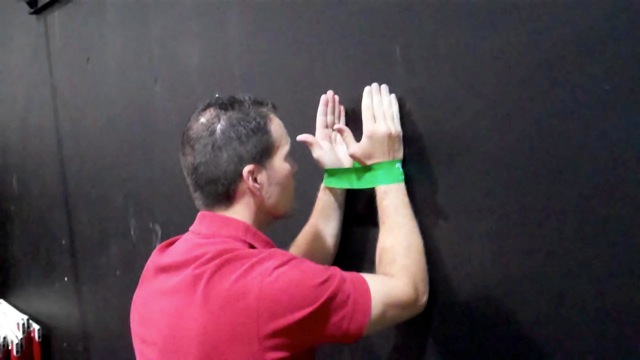
During the next several columns, I will address some common scapular problems and some straightforward strategies to address them. In today's column, I will address a corrective exercise I use to address excessive scapular abduction syndrome.
Execution: Place a mini band around the wrists and position the elbows at shoulder height (90 degrees of shoulder flexion). Be sure there is light tension at rest. Next, slowly horizontally abduct the humerus and pull the medial border of the shoulder blade toward the spine (scapular adduction). Pause, and return to the start position.
Alternate sides for 10-15 repetitions or time. Repeat 2-3 sets on each side. During the movement, focus on maintaining good control and scapular alignment on the contralateral side. That forearm should not move or lose contact with the wall.
 |  |
Application: This exercise is designed to strengthen the middle trapezius and rhomboids. In addition, it will improve scapular stability. Scapular abduction is usually more evident with elevation from 90-180 degrees as the ratio of scapular movement to glenohumeral movement is 1:1 instead of the normal 1:2 ratio throughout since the scapula is already in an excessively abducted posture at rest.
This alignment is often synonymous with excessive length of the trapezius (possibly the rhomboids) and shortness of the serrratus anterior. Tightness in the pectoralis muscles is also a factor to consider, and stretching may be indicated in addition to the strengthening.
The serratus anterior along with the pec major/minor may exert a more dominant pull than the trapezius and rhomboid muscles. This position may cause glenohumeral joint impingement, tendonitis, interscapular pain or even sternoclavicular joint pain.
Additional Notes:
-When choosing resistance, it is imperative that proper form is maintained throughout.
-To advance the exercise, simply slide the arms further up the wall to work on higher ranges of elevation.
Brian Schiff, PT, CSCS, is a licensed physical therapist, respected author and fitness professional. Currently, he serves as the supervisor at the Athletic Performance Center in Raleigh, NC. Brian presents nationally at several professional conferences and seminars on injury prevention, rehab and sport-specific training. For more cutting edge training information, subscribe to his monthly Training & Sports Medicine Update at www.BrianSchiff.com.
















